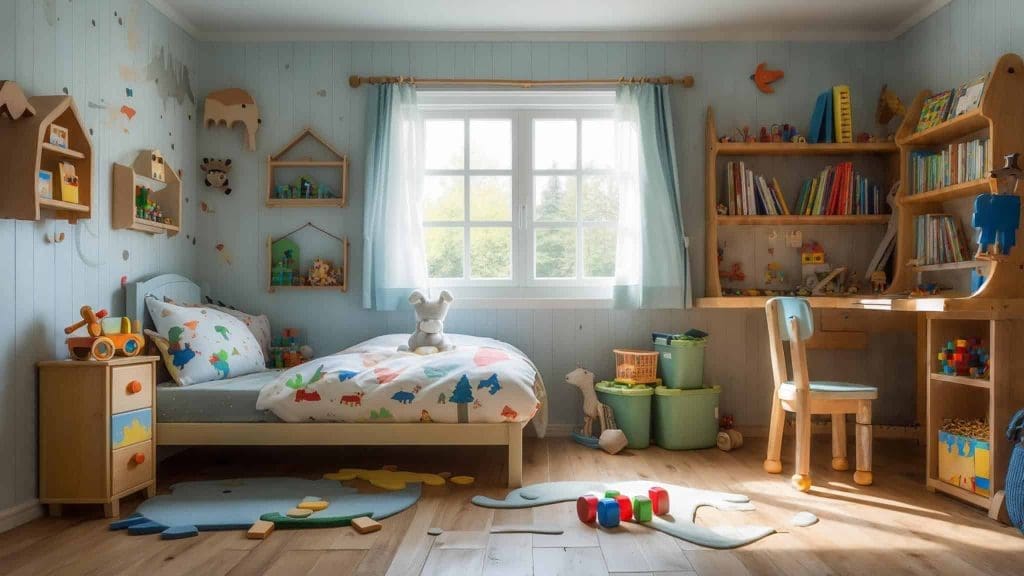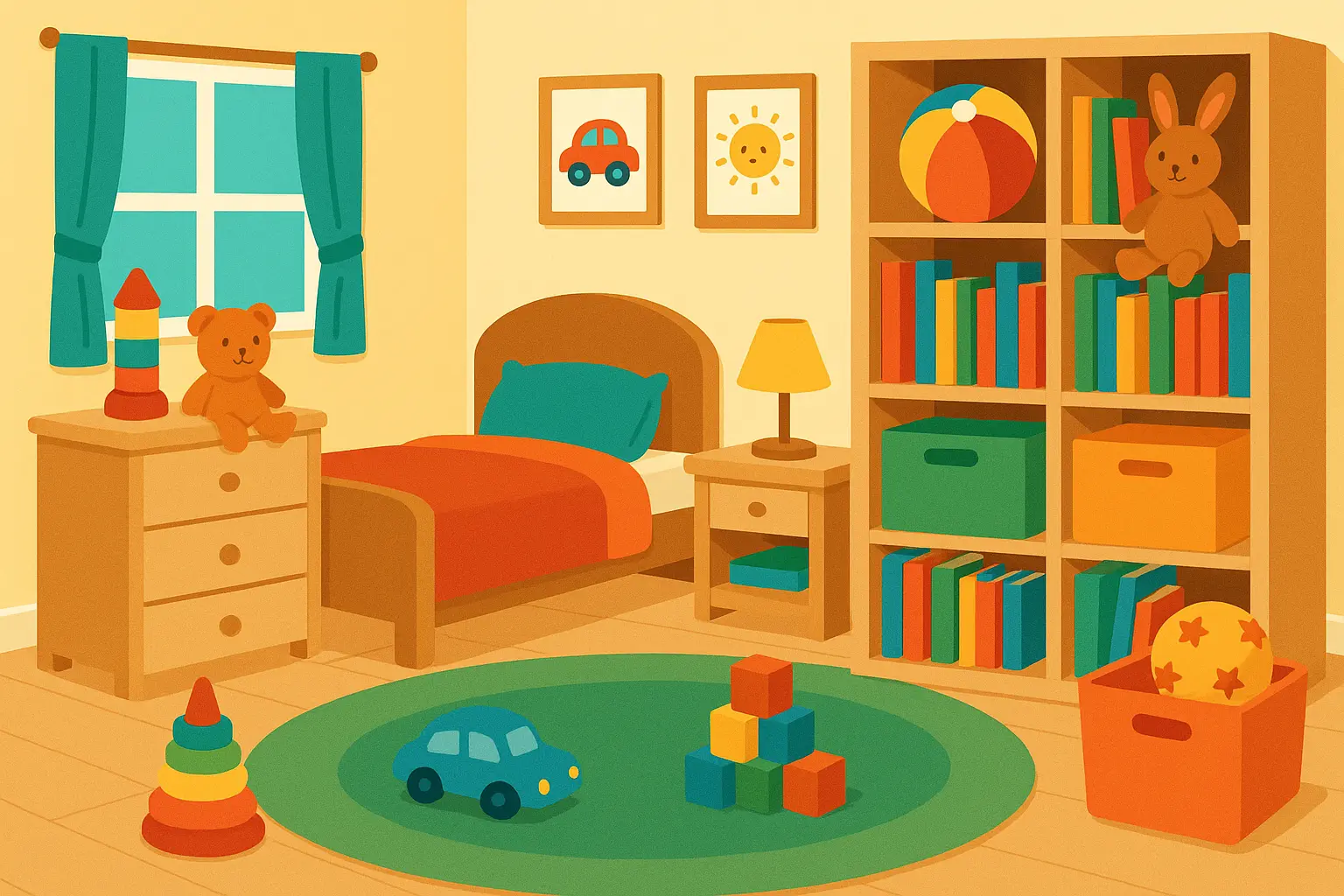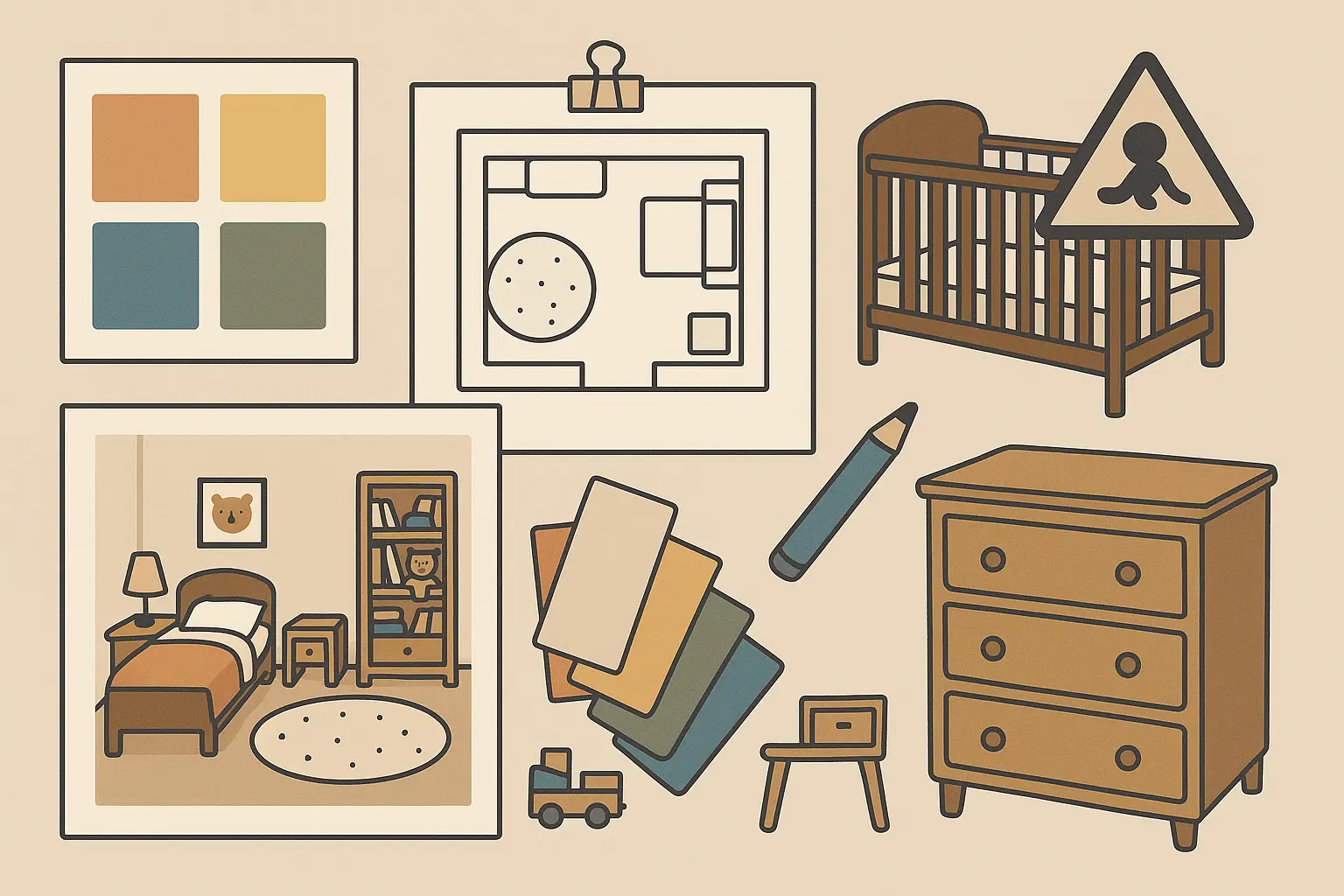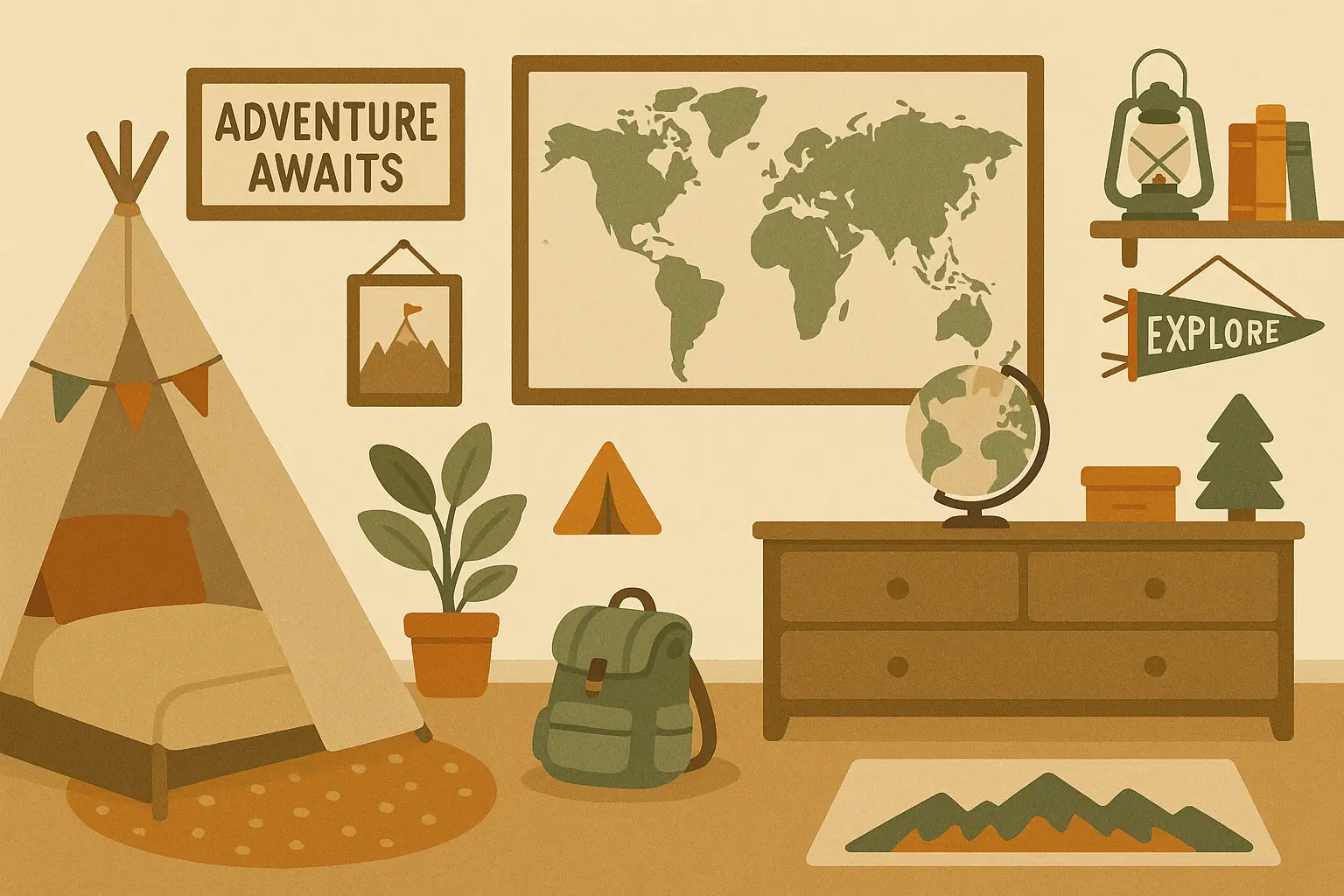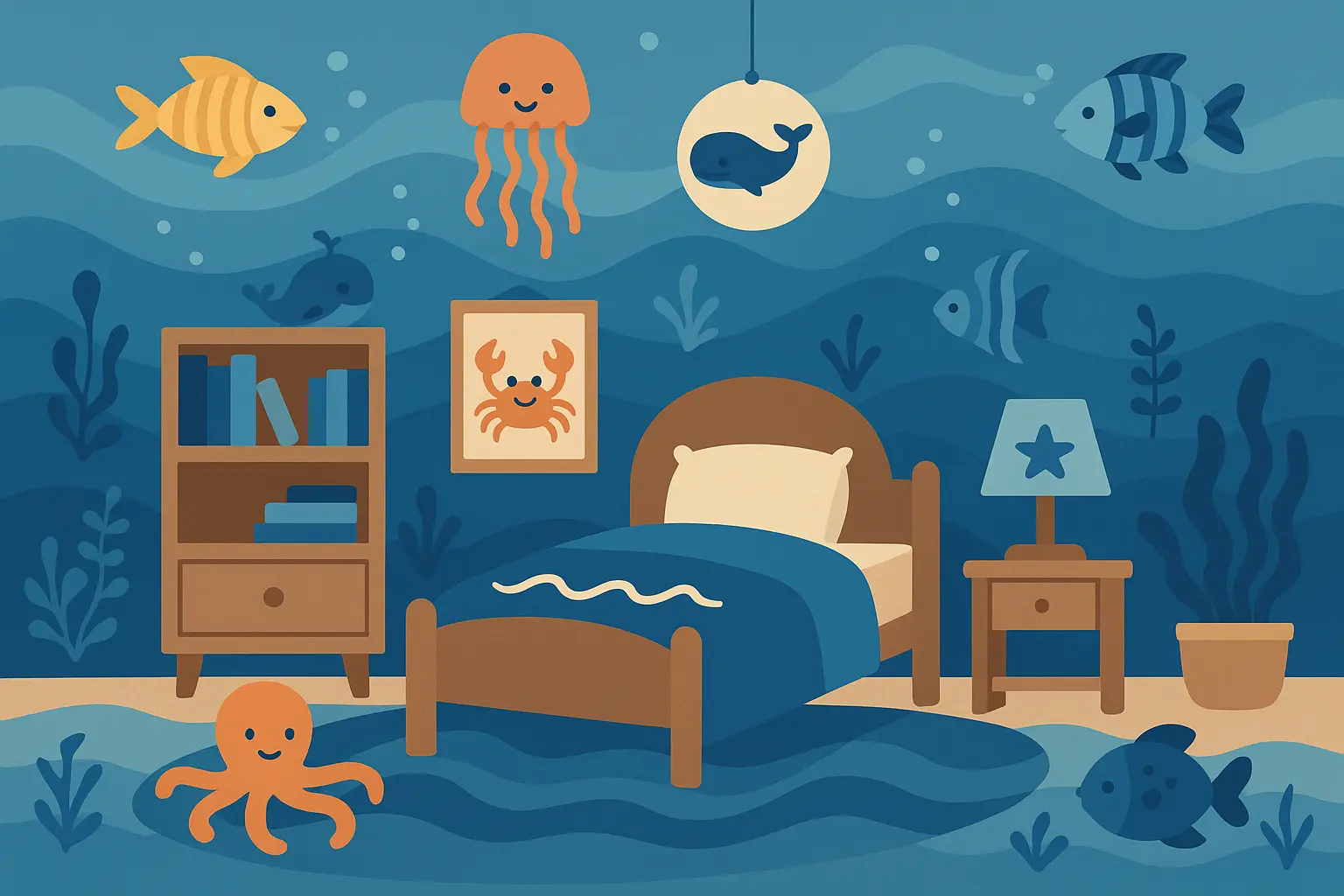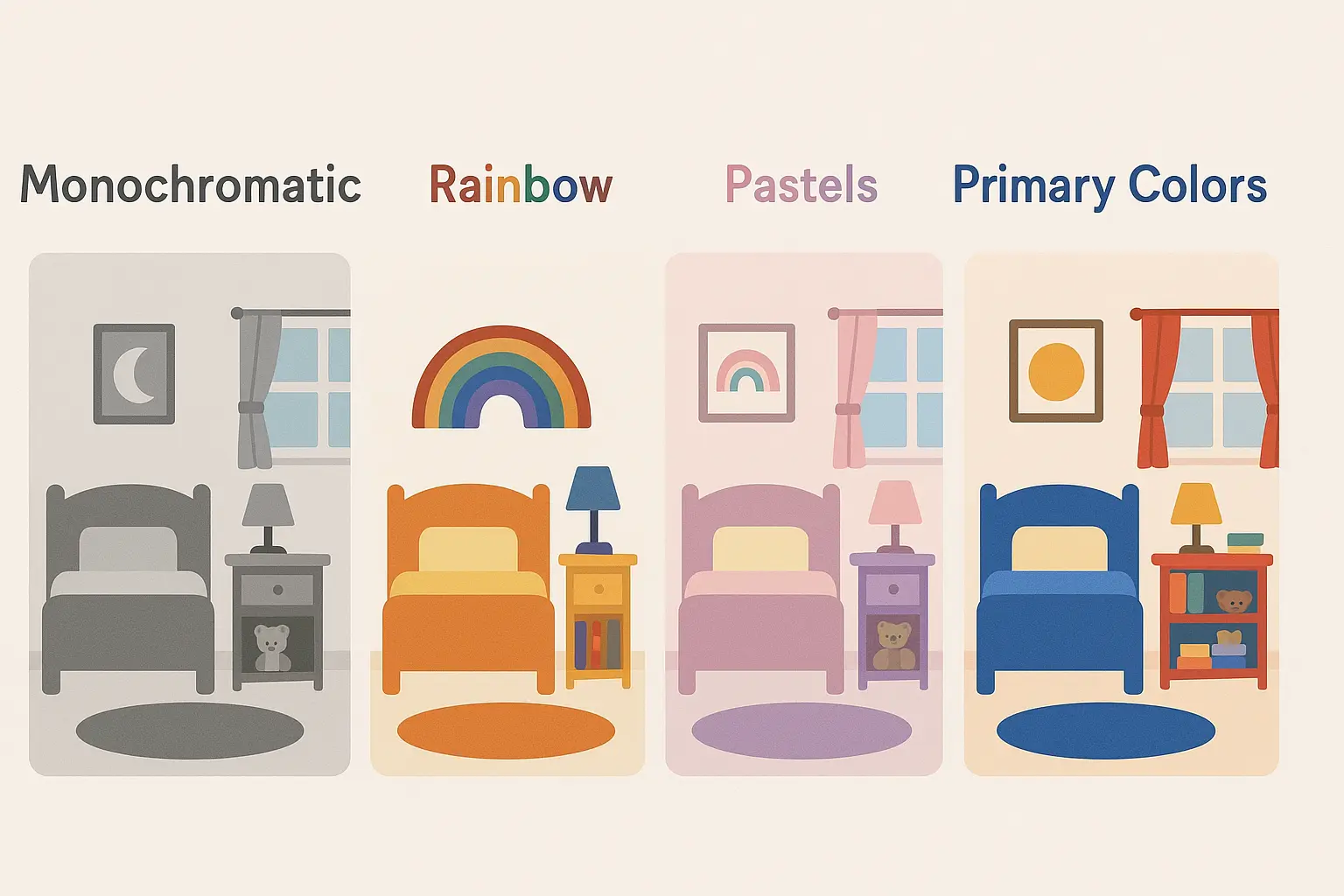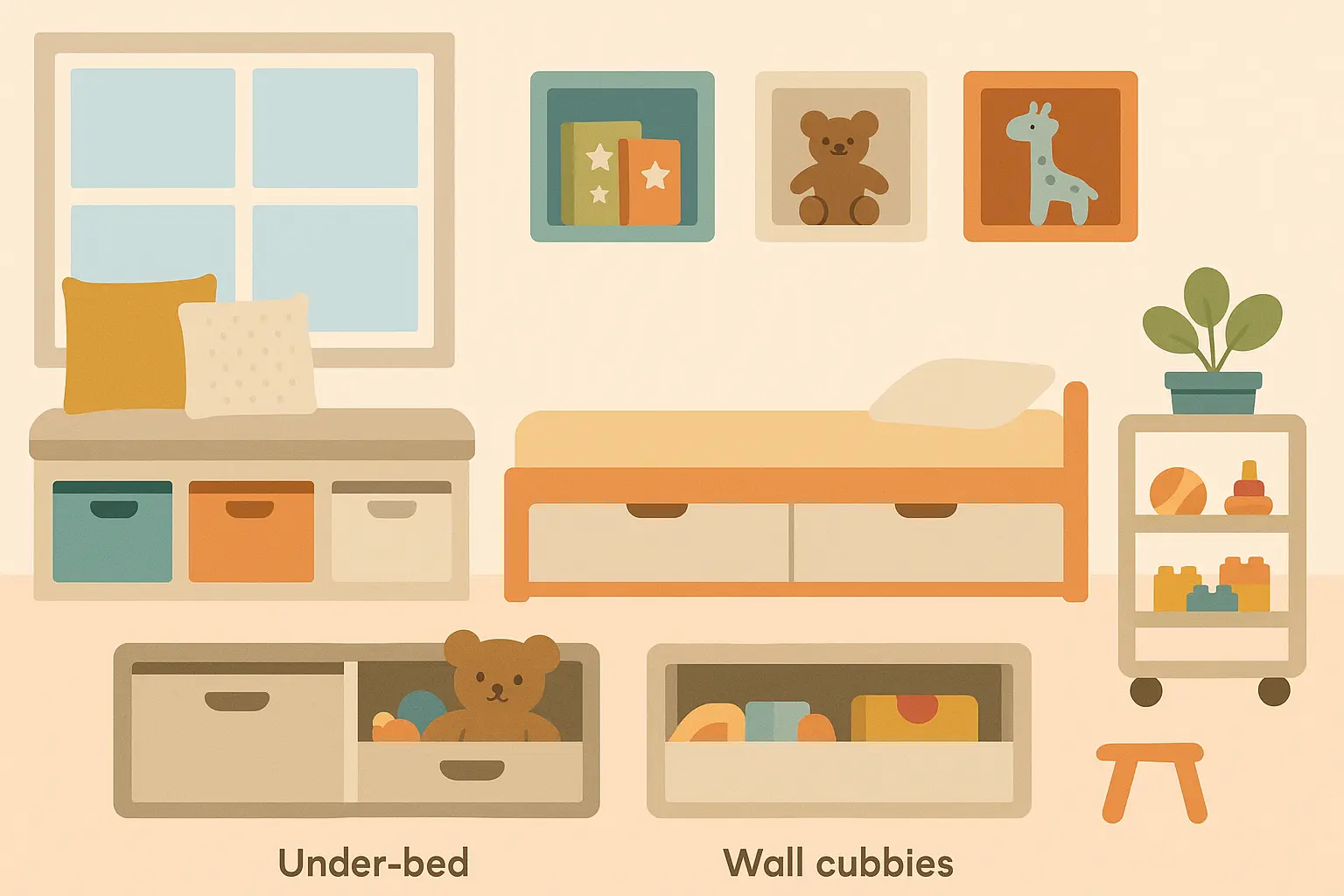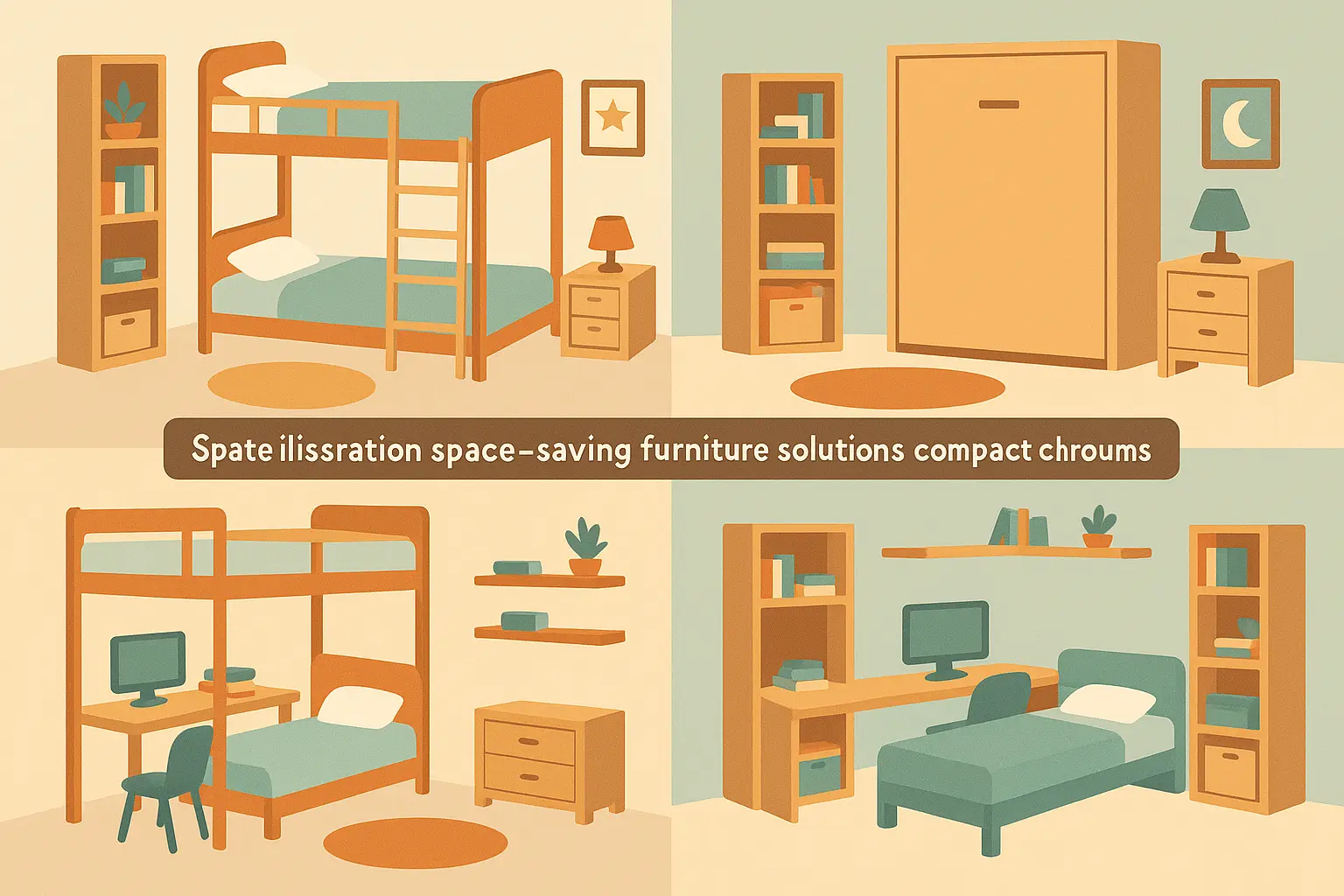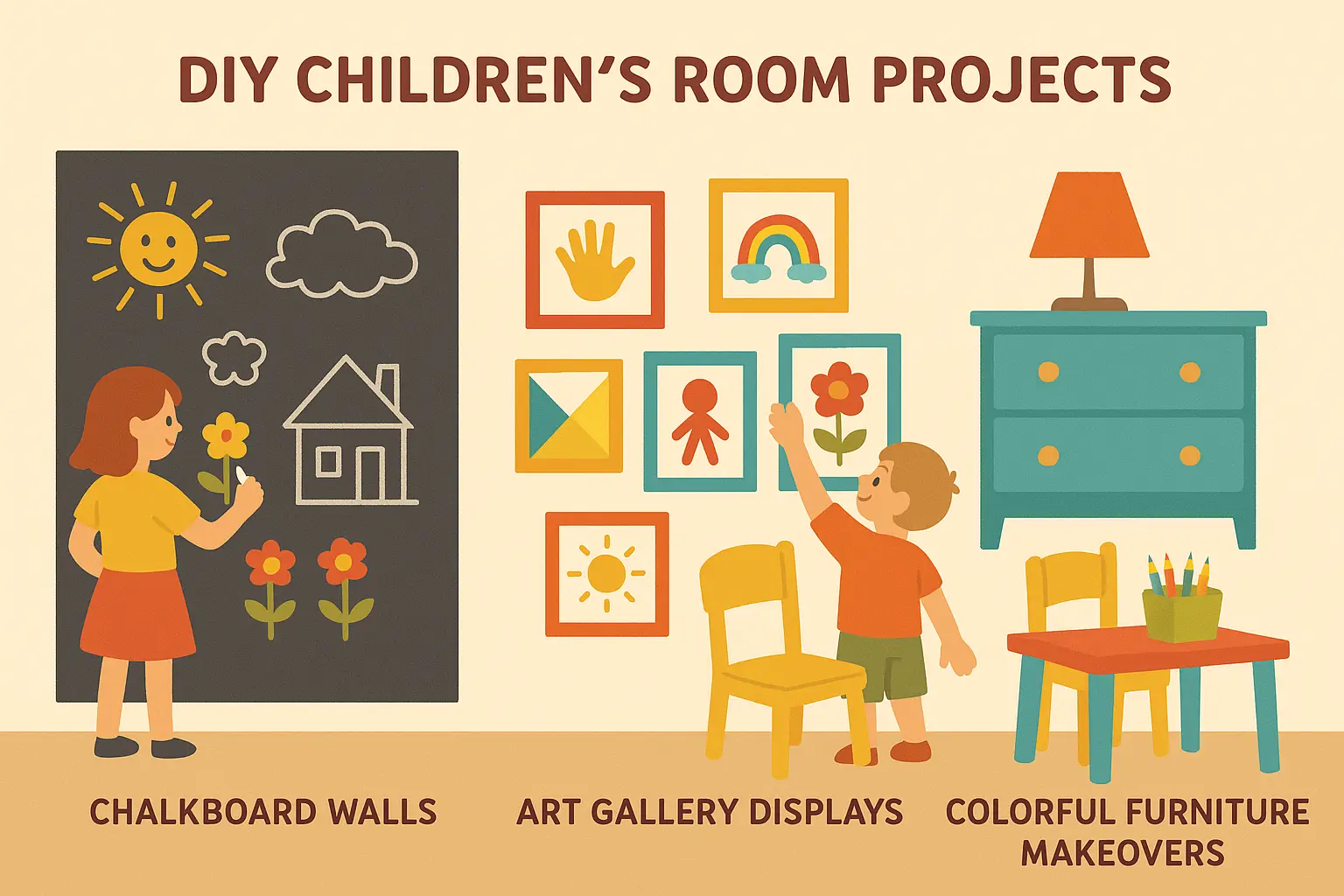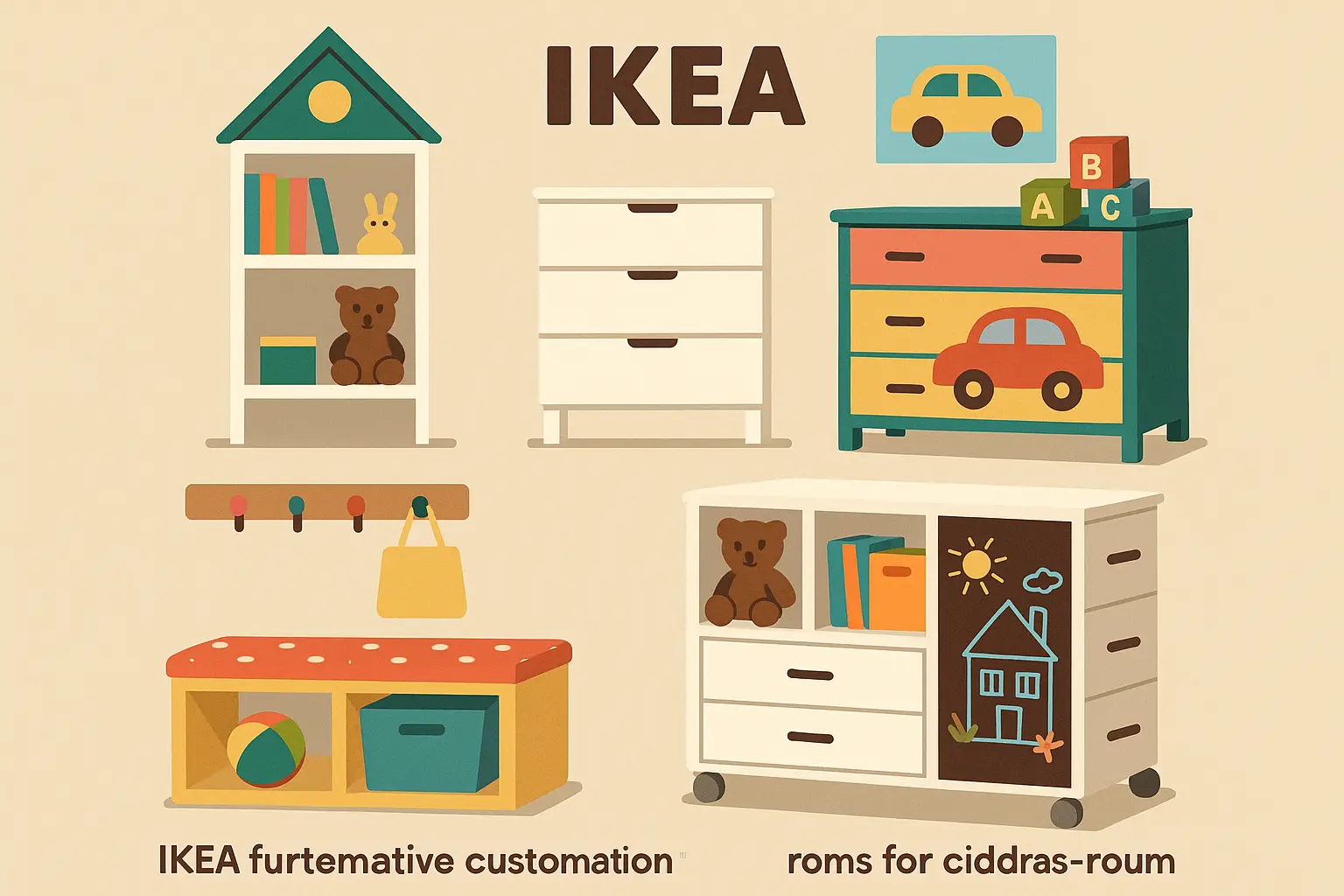25 Creative Kids Room Ideas That Will Transform Your Child’s Space Into Their Dream Haven
Let’s be honest – kids’ rooms need to do EVERYTHING. They’re bedrooms, playrooms, art studios, homework stations, and fort-building headquarters all rolled into one chaotic, wonderful space. I’ll never forget when my nephew’s room was just a basic bed and dresser setup – it looked sad and empty, like a hotel room. But after we added some creative storage solutions and splashed personality everywhere through color, it became his absolute favorite spot where he’d spend hours building elaborate block cities and reading every adventure story he could get his hands on.
Here’s the thing nobody tells you about designing kids’ rooms – it’s not just about making something that looks cute for your Instagram feed. You’re creating a space that needs to grow with your child, survive their ever-changing interests (seriously, how do they go from dinosaurs to space to unicorns in one week?), and somehow not completely destroy your budget in the process.
Whether you’re starting from scratch or refreshing a room that’s seen better days, these 25 kids room ideas will help you create something that’s both practical and magical – because let’s face it, our kids deserve a little magic in their everyday spaces.
Table of Contents
-
TL;DR: Quick Takeaways
-
Essential Planning Considerations for Kids Room Design
-
Theme-Based Room Designs (Ideas 1-5)
-
Color-Focused Design Schemes (Ideas 6-9)
-
Smart Storage and Organization Solutions (Ideas 10-15)
-
Space-Saving Design Solutions (Ideas 16-19)
-
Creative DIY Projects (Ideas 20-22)
-
Budget-Friendly IKEA Solutions (Ideas 23-25)
-
How JiffyJunk Can Help Your Room Transformation
-
Final Thoughts
TL;DR: Quick Takeaways
-
Okay, I’m going to sound like your mom here, but safety really isn’t negotiable – choose non-toxic materials, anchor heavy furniture to walls (seriously, do this), and pick age-appropriate elements
-
Invest in timeless base pieces that won’t look ridiculous in three years, then go wild with easily changeable decor that can evolve with your child’s obsessions
-
Multi-functional furniture is your best friend – think storage ottomans, loft beds with study areas, and window seats that hide all their random collections
-
Theme-based designs work when they can grow up – an explorer theme can evolve from “let’s play camping” to actual geography lessons
-
Color schemes can make or break the vibe – choose based on whether your kid needs calming energy or can handle rainbow explosions
-
Vertical storage solutions save your sanity by maximizing floor space for the inevitable toy tornado
-
IKEA hacks give you that custom look without the custom price tag (and yes, assembly will take longer than expected)
-
DIY projects add personal touches without breaking the bank – chalkboard walls and art galleries are surprisingly doable
-
Space-saving solutions work miracles in smaller rooms with clever bunk beds and Murphy bed setups
-
Professional junk removal services handle the overwhelming “clearing out” phase so you can focus on the fun decorating parts
Essential Planning Considerations for Kids Room Design
Before you get swept away browsing Pinterest and filling your cart with adorable decor, let’s talk about the foundation stuff that actually matters. Trust me on this – I’ve seen too many beautiful rooms that were completely impractical for real life.
Safety First (Yes, I Sound Like Your Mom, But Here We Are)
Your child’s safety trumps every single design choice you’ll make, no matter how cute that wobbly bookshelf looks in the store. Non-toxic materials aren’t just a nice-to-have – they’re absolutely essential. This means actually reading labels on paint, furniture finishes, and even those adorable wall decals.
Furniture with rounded edges will save you from countless “I bonked my head” tears. And please, PLEASE anchor heavy furniture to the walls. I can’t tell you how many parents I know who thought their dresser was stable until their toddler decided to use the drawers as stairs.
Age-appropriate elements matter more than you think. That climbing wall might look amazing, but ask yourself: do you really want to encourage MORE climbing? What works for a careful 8-year-old might be a disaster waiting to happen with an adventurous 4-year-old.
When planning your kids room design ideas, consider how furniture removal services can help clear out unsafe or outgrown pieces before you start fresh with safety-focused designs.
|
Age Group |
Safety Priorities |
Furniture Considerations |
Material Guidelines |
|---|---|---|---|
|
Toddlers (2-4) |
Rounded corners, outlet covers, secure furniture anchoring |
Low beds, soft furnishings, no small parts |
Non-toxic paints, washable fabrics, lead-free finishes |
|
School Age (5-10) |
Proper lighting, stable furniture, clear pathways |
Adjustable desks, sturdy storage, ergonomic seating |
Durable materials, stain-resistant surfaces, easy maintenance |
|
Tweens/Teens (11+) |
Privacy considerations, electrical safety, weight limits |
Full-size furniture, professional desk setups, mature storage |
Quality materials, sophisticated finishes, long-term durability |
Functionality and Smart Storage Planning
Here’s what I wish someone had told me: multi-purpose furniture isn’t just trendy – it’s survival. A storage ottoman becomes seating for story time, toy storage for cleanup, and a makeshift table for puzzle adventures. You’ll need storage for the constant avalanche of toys, clothes, books, and those random collections kids seem to accumulate (why do they need seventeen rocks from the backyard?).
Easy maintenance should guide every single material choice you make. That gorgeous white carpet might look stunning in the showroom, but it won’t survive one week with a kid who thinks markers are meant for everything except paper.
Organization systems work best when kids can actually use them independently. This isn’t just about teaching responsibility – it’s about preserving your sanity when they can put their own stuff away.
Let me tell you about my friend Sarah’s brilliant solution for her 5-year-old Emma’s room. Instead of a traditional toy chest (which became a black hole where toys went to die), they installed a window seat bench. Emma gets a cozy reading spot, books stay organized underneath, and the cushioned top is perfect for snuggling. Emma can reach everything herself, the parents get a clean look, and everyone’s happy. Win-win-win.
Growth and Adaptability Planning
Fair warning: If your kid is anything like mine, their favorite color will change approximately every Tuesday. That’s why timeless base pieces are your secret weapon. A solid wooden bed frame looks just as good for a 5-year-old obsessed with unicorns as it does for a 15-year-old who’s suddenly “too cool” for anything fun.
Trust me on this – that adorable toddler bed? They’ll outgrow it faster than you think. Plan for future needs now, because that play area will eventually become a study zone, and those toy bins will transform into sports equipment storage.
Budget and Practical Considerations
Look, I know that $800 IKEA transformation sounds amazing, but let’s talk about what that actually looks like when you’re buying everything at once. Cost-effective doesn’t mean cheap – it means being smart about where you splurge and where you save.
Pro tip: Start with one corner. Seriously. Don’t try to do the whole room unless you enjoy stress-crying in Target. Balance is everything – invest in pieces that will last while finding creative ways to add personality without emptying your bank account.
Personal Style and Family Lifestyle Integration
Your child’s interests should definitely influence the design, but remember – they went from loving dinosaurs to being obsessed with space to declaring they’re “only into art now” in the span of two months. Build in flexibility for these rapidly evolving preferences.
Your family’s daily routines matter too. If homework happens in the bedroom, you need proper lighting and a real desk space, not just a cute little table that looks good in photos.
Theme-Based Room Designs
Theme-based designs can create magical spaces that spark imagination – when done right. The key is choosing themes that can evolve as your child grows, because trust me, their obsessions will change faster than you can redecorate.
1. Adventure Explorer Theme
Turn your child’s room into base camp for young adventurers using earth tones, camping-inspired elements, and geography features that actually teach them something cool.
Earth tones create that authentic outdoor vibe with forest green, khaki, and brown as your foundation. Install a tent-style reading nook using fabric and a simple frame – this becomes their secret hideaway for books and quiet time. World map wall decals pull double duty as decoration and sneaky education tools.
My friend’s 6-year-old has an explorer room, and I love watching him “plan expeditions” to different countries on his wall map. What started as simple pretend play has turned into genuine curiosity about different cultures and places. The vintage suitcase storage adds authentic explorer vibes while actually organizing all his adventure gear (flashlights, binoculars, and approximately forty-seven rocks he’s collected).
String lights create that cozy campfire feeling without any fire hazards. The beauty of this theme? It grows beautifully from simple exploration play to serious geography studies as kids get older.
2. Space Galaxy Theme
Create an out-of-this-world experience that makes bedtime feel magical instead of like a battle you’re destined to lose.
Deep blues, purples, and blacks with metallic silver accents form your cosmic color foundation. Glow-in-the-dark stars on the ceiling provide gentle nighttime lighting while creating wonder. Planet wall decals and a rocket ship bookshelf add thematic elements that actually serve practical purposes.
Here’s something I learned the hard way from my neighbor’s space room experiment: glow-in-the-dark everything sounds amazing until your kid’s room looks like a rave at bedtime. Sometimes less really is more, even with cosmic decor.
LED strip lighting creates that futuristic vibe – just make sure all lighting is child-safe and properly installed. The educational potential here is huge – this theme naturally leads to conversations about astronomy, science, and space exploration.
3. Fairy Tale Forest Theme
Bring enchanted woodland magic indoors with tree elements, woodland creatures, and natural textures that create a surprisingly calming environment.
Soft greens, browns, and cream colors create a soothing palette that actually helps with bedtime (unlike some other themes I could mention). A tree bookshelf becomes both storage solution and major wow factor. Forest animal wall decals add whimsy without overwhelming the space.
The key with this theme is using natural elements that are properly treated and safe for indoor use. Fairy lights create magical ambiance while providing practical lighting. Mushroom stools and leaf-shaped rugs complete that forest floor experience.
This theme grows beautifully from fairy tale magic to nature appreciation and environmental awareness as kids mature.
4. Superhero Headquarters Theme
Design a command center for young heroes using bold colors and heroic elements that inspire confidence (and hopefully better behavior).
Primary colors with black accents create that classic superhero feeling. A city skyline wall mural sets the scene – this can be painted or created with removable decals for us commitment-phobic parents.
Include a “transformation” area with organized costume storage. Trust me, if you’re going superhero, you need somewhere to contain all those capes and masks. A command center desk supports both superhero play and actual homework.
The trick is balancing branded superhero items (which can get expensive fast) with DIY superhero elements you create yourself. This theme evolves beautifully from cartoon heroes to real-world hero appreciation – firefighters, doctors, teachers.
5. Under the Sea Ocean Theme
Dive into an aquatic wonderland using blue hues, sea creatures, and wave patterns that create a surprisingly calming water-inspired environment.
Various shades of blue with coral, green, and sandy beige accents mimic real ocean colors. Wave-pattern wall painting creates movement and visual interest. Sea creature mobiles and seashell decorations add thematic touches without going overboard (pun intended).
This theme naturally develops into marine biology interests as children grow, making it one of those rare themes that actually gets more educational over time.
Color-Focused Design Schemes
Color schemes can make or break the vibe of your kid’s room. Choose based on your child’s personality – some kids thrive with rainbow energy, others need calming monochromatic spaces to function.
6. Monochromatic Magic
Create sophisticated depth using different shades within one color family – this reduces visual chaos while still being interesting to look at.
Choose one color family like blues (from navy to powder blue) or greens (from forest to mint). Use different textures and patterns within your chosen color to create visual interest without overwhelming the space. Think navy velvet pillows, powder blue cotton curtains, and medium blue geometric rugs.
The single color approach creates a calming environment that’s actually conducive to both rest and focus. It’s sophisticated enough to grow with your child from toddler years through their teenage “everything is embarrassing” phase.
This works particularly well for kids who get overstimulated by too much visual input or prefer calm, organized environments.
7. Rainbow Bright Explosion
Embrace all colors of the rainbow in a cheerful, energetic design – but fair warning, I tried this with my nephew and within a week he was complaining it was “too loud.” Know your child before you commit to this level of color chaos
Rainbow wall stripes, multicolored storage bins, and rainbow bookshelves create an energetic atmosphere. Balance all this color with white furniture to prevent the space from becoming completely overwhelming.
Color-coded storage actually helps with organization – red bin for art supplies, blue for building blocks, green for dress-up clothes. This system teaches color recognition while maintaining some semblance of order.
The challenge? Coordinating many different colored items can get expensive, and this approach may need toning down as children develop more sophisticated tastes.
When implementing kids room decorating ideas like rainbow themes, consider decluttering services to remove items that clash with your new color scheme.
Let me tell you about the Martinez family’s genius solution for their twin 4-year-olds’ shared rainbow room. They assigned each child a color scheme – one got warm colors (red, orange, yellow) and the other cool colors (blue, green, purple). Storage bins, bed linens, and personal items followed this system, making it easy for the kids to identify their belongings while maintaining the rainbow aesthetic. Brilliant, right? It reduced sibling fights over toys and taught color recognition naturally.
8. Soft Pastels Paradise
Create a gentle, soothing environment with muted pastel tones that actually promote better sleep (revolutionary concept, I know).
Soft pink, lavender, mint green, and butter yellow work together harmoniously. Cloud-like textures, gentle patterns, and soft lighting enhance the peaceful atmosphere. This palette naturally promotes relaxation and reduces anxiety.
The peaceful environment supports both concentration and rest – crucial for kids who are sensitive or easily overstimulated. Pastels have timeless appeal that works from toddler years through teenage years without feeling babyish.
9. Bold Primary Statement
Make a strong impact with classic primary colors used strategically rather than everywhere at once.
Try a red accent wall with blue and yellow accessories, or primary colored furniture against white walls. The key is using these bold colors strategically rather than painting everything red, blue, and yellow like a McDonald’s PlayPlace.
Bold colors can be stimulating, so balance them with calmer elements. Primary colors are perfect for younger children learning color recognition, and these classic combinations never really go out of style.
Smart Storage and Organization Solutions
Let’s talk about storage, because isn’t it always about storage? Kids accumulate stuff at an alarming rate, and somehow they always know exactly where that one specific toy is in the chaos.
10. Built-in Window Seat with Storage
Turn that awkward window space into the reading spot your kid will actually use – this maximizes an often underutilized space while creating a special retreat.
Custom-build or purchase a window seat that spans your window’s width. The lift-up cushioned top provides access to the storage compartment below. Add side shelving for books and decorative items. Include an electrical outlet nearby for reading lamps and device charging.
Please, PLEASE add safety locks if needed to prevent the lid from slamming on small fingers – trust me on this one. This solution provides seating, storage, and reading space in one efficient package.
The higher initial investment pays off with excellent long-term value. Window seats remain useful from toddler years through teenage years, adapting to changing needs beautifully.
11. Under-Bed Storage Drawers
Maximize space efficiency with rolling drawers that fit perfectly under bed frames – though fair warning, under-bed storage sounds genius until you realize you’ll be crawling around on the floor every time they need pajamas.
Custom-built drawers on wheels, plastic storage containers with lids, or fabric bins that slide easily all work well. Organize by category: out-of-season clothes, extra bedding, toys, or sports equipment. Smooth-rolling wheels and rounded edges ensure safety.
This solution doubles your floor space utility without taking up additional room. Storage needs evolve, but the space remains useful throughout childhood.
12. Wall-Mounted Cubbies and Shelves
Create vertical storage that maximizes wall space without consuming valuable floor area for play activities.
Install floating shelves at various heights to accommodate different items and your child’s changing reach. Include cube storage units for toys and books. Add hooks for backpacks and jackets.
Proper anchoring to wall studs is crucial for safety – and yes, I mean actually finding the studs, not just hoping for the best. This approach maximizes vertical space while keeping items accessible and organized.
|
Storage Solution |
Space Required |
Cost Range |
Best For |
Longevity |
|---|---|---|---|---|
|
Window Seat Storage |
Window wall space |
$200-800 |
Reading nooks, seasonal items |
15+ years |
|
Under-bed Drawers |
Under bed footprint |
$50-300 |
Clothes, toys, bedding |
10+ years |
|
Wall-mounted Cubbies |
Vertical wall space |
$100-500 |
Books, display items, daily use |
10+ years |
|
Multi-purpose Ottomans |
Floor space (moveable) |
$75-250 |
Toys, extra seating |
8+ years |
|
Closet Organization |
Existing closet space |
$150-600 |
Clothes, accessories |
10+ years |
|
Rolling Carts |
Minimal floor space |
$40-150 |
Art supplies, mobile storage |
5+ years |
13. Multi-Purpose Ottoman Storage
Combine seating, storage, and style in versatile furniture pieces that adapt to different activities throughout the day.
Large storage ottomans serve as toy chests and extra seating for friends. Smaller ottomans can be moved around the room as needed. Choose ottomans with removable tops for easy access to contents.
I spent $200 on fancy toy bins once, and guess what my kids use them for? Everything BUT toys. Now they’re full of rocks, sticks, and other “treasures” from the backyard. At least ottomans serve multiple purposes when kids inevitably repurpose them.
14. Closet Organization Systems
Transform closets into efficient storage powerhouses with custom organization that maximizes every inch of available space.
Install adjustable shelving, double-hang rods for shorter items, shoe racks, and drawer systems. Include specialized storage for different clothing types and accessories. Add lighting for better visibility.
This approach maximizes closet space efficiency while teaching valuable organization skills – though those cute little bins will get dumped out regularly when they’re searching for one specific toy that’s somehow always at the bottom.
15. Rolling Storage Carts
Create mobile organization that moves where needed throughout the day – perfect for children’s constantly changing activity patterns. Just be aware that rolling carts are amazing until they become racing cars. Just saying.
Art supply carts roll to desk areas when it’s creative time. Toy carts move from play areas to storage when cleanup time arrives. Book carts can travel throughout the house for reading anywhere.
Ensure wheels lock securely and carts remain stable when loaded. This provides flexible storage that adapts to different activities throughout the day.
Space-Saving Design Solutions
Space-saving solutions work miracles in smaller rooms or when you’re trying to fit multiple kids into one space without them driving each other (and you) completely insane.
16. Loft Bed with Study Area Below
Maximize vertical space by combining sleeping and study areas – this creates two distinct functional zones in the footprint of one.
Install a loft bed with sturdy ladder and safety rails that meet current safety standards. Below, create a complete study station with desk, chair, shelving, and task lighting. Include electrical outlets for computers and lamps.
Safety is absolutely paramount – the bed must meet strict standards for height, railings, and ladder stability. This solution creates two functional areas in limited space, with the study area becoming increasingly important as children advance in school.
17. Murphy Bed or Daybed Setup
Create flexible spaces that serve multiple functions throughout the day – bedroom at night, playroom or study room during the day.
Wall-mounted Murphy beds fold up to create floor space for play. Daybeds with trundles accommodate sleepovers. Each option provides different levels of flexibility for families who need rooms to multitask.
When implementing space-saving kids room ideas, mattress removal services can help dispose of old bedding when transitioning to new space-efficient sleeping solutions.
18. Corner Desk and Reading Nook
Turn that awkward corner space into the most coveted spot in the room – corners often go unused in standard room layouts but can become highly functional with proper planning.
Install L-shaped corner desks with wrap-around shelving above. Add comfortable seating with cushions and pillows. Include task lighting and storage for supplies.
Corner installations can be DIY projects or custom installations depending on your budget and skill level. Corner nooks naturally feel cozy and personal to children.
19. Bunk Beds with Built-in Storage
Combine sleeping space for siblings or sleepovers with integrated storage – maximizing both sleeping capacity and organization in one piece.
Choose bunk beds with built-in drawers, shelves, or desk areas. Include individual lighting and storage for each sleeping area. Consider L-shaped bunks for more floor space.
My neighbor’s kids have been begging for bunk beds for months, but she was terrified they’d turn into jungle gyms. The compromise? Bunk beds with strict “no climbing except on the ladder” rules and built-in storage that makes the investment worthwhile.
Creative DIY Projects
DIY projects add personal touches and creative elements while staying budget-friendly – though be prepared for projects to take approximately 847% longer than expected when kids are “helping.”
20. Chalkboard or Whiteboard Wall
Transform an entire wall into a creative canvas for drawing, learning, and self-expression.
Apply chalkboard paint or install large whiteboard panels on one wall. Include chalk or marker storage nearby for easy access. Add proper lighting to reduce glare and ensure good visibility.
Chalkboard paint seems foolproof until you realize your artistic child has now decorated the baseboards, door frame, and somehow the ceiling. Set clear boundaries about where the “canvas” begins and ends.
This provides huge creative space and serves as an educational tool for practicing letters, numbers, and drawing. The wall remains useful from toddler scribbles to teenage study notes and planning.
21. Gallery Wall of Children’s Art
Create dedicated spaces to display and celebrate your child’s creativity – this builds confidence and encourages continued artistic development.
Use removable frames for easy artwork swapping. Create clothesline displays with clips for quick changes. Install magnetic boards for effortless updates.
Gallery walls are beautiful until you’re changing out 47 pieces of artwork every week because “this one’s not my favorite anymore.” The Chen family solved this by creating a rotating system – their 7-year-old Marcus selects his five favorite pieces each month to display, with a storage portfolio for the rest.
22. Repurposed Furniture Makeover
Transform second-hand or existing furniture into unique, personalized pieces that reflect your family’s creativity.
Sand and repaint old dressers in fun colors. Add new hardware featuring your child’s favorite themes. Decoupage furniture with maps or comic book pages. Add chalkboard paint sections for labeling contents.
I once spent three hours assembling a “simple” storage cube only to realize I’d put the door on upside down. Sometimes buying quality used pieces and giving them a makeover is easier than starting from scratch.
Before starting furniture makeover projects in your kidsroom, consider furniture pickup services to donate pieces that can’t be repurposed.
Budget-Friendly IKEA Solutions
IKEA hacks give you that custom look without the custom price tag – though that $150 hack estimate? Add another $50 for the trips back to IKEA because you forgot the screws, bought the wrong size brackets, and needed more storage boxes than you thought.
23. IKEA Hack Storage Solutions
Transform basic IKEA pieces into custom storage that looks expensive but costs a fraction of built-in alternatives.
Add doors to KALLAX cubes for hidden storage. Create reading nooks by placing KALLAX units around mattresses. Turn TROFAST bins into custom toy organization systems. Combine multiple IVAR shelving units for library walls.
IKEA pieces are designed for easy customization, making them perfect foundations for creative hacks. Just remember – IKEA assembly with kids “helping” takes approximately forever.
|
IKEA Product |
Original Price |
Hack Potential |
Estimated Total Cost |
Professional Equivalent |
|---|---|---|---|---|
|
KALLAX 4×4 Unit |
$80 |
Reading nook + storage |
$150 |
$800+ built-in |
|
TROFAST System |
$45 |
Custom toy organization |
$85 |
$400+ custom bins |
|
IVAR Shelving |
$60 |
Library wall system |
$200 |
$1200+ built-ins |
|
STUVA Storage |
$120 |
Complete wardrobe system |
$250 |
$1500+ custom closet |
|
HEMNES Daybed |
$200 |
Multi-function seating/sleeping |
$300 |
$1000+ custom daybed |
24. Modular Furniture Systems
Use IKEA’s modular approach to create flexible room layouts that evolve with your child’s changing needs.
Combine STUVA storage units in different configurations. Use ALGOT wall-mounted systems that adjust and expand easily. Create play areas with FLISAT children’s furniture that rearranges as needed.
Modular systems adapt to changing needs without replacing entire pieces. Components can be reconfigured rather than replaced as children grow – which is great because their interests change faster than you can keep up with.
25. Budget-Friendly Room Transformation
Create complete room makeovers using primarily IKEA pieces and smart shopping strategies.
Use HEMNES daybeds for flexible sleeping and seating. BILLY bookcases provide storage and display. STUVA wall-mounted storage organizes toys. MAMMUT children’s furniture creates play areas. Complete room transformations typically cost under $800.
Each piece serves multiple purposes to maximize value, and individual pieces can be replaced or added without complete overhauls. The clean, coordinated appearance can be personalized with accessories while maintaining a cohesive look.
When implementing ikea kids room ideas for complete transformations, garage cleanout services can help clear storage areas to make room for new furniture pieces before assembly.
How JiffyJunk Can Help Your Room Transformation
Look, I get it – clearing out your kid’s room feels overwhelming. There’s the broken toys you can’t bear to throw away, the clothes they’ve outgrown but you’re saving “just in case,” and furniture that seemed like a good idea three years ago.
When implementing any of these kids room ideas, you’ll face a common challenge: dealing with all the stuff that needs to go before your transformation begins. Sometimes you need professionals to come in and just… handle it. No judgment, no guilt trips about that expensive toy they used twice.
JiffyJunk’s services clear spaces by removing old furniture, outgrown toys, and accumulated items that are taking up valuable real estate. Our team handles heavy furniture pieces, old electronics, and bulky items safely without damaging your home.
Our eco-friendly approach means items with remaining life get donated to local charities. Your child’s outgrown toys and furniture bring joy to other families instead of ending up in landfills – which feels pretty good when you’re drowning in stuff.
Rather than renting trucks, buying equipment, or making multiple trips to donation centers, our transparent pricing (starting at $100) often proves more cost-effective than DIY removal, leaving more budget for the fun decorating parts.
Time-saving service allows you to focus energy on creative design aspects rather than removal logistics. Room transformations should be exciting, but clearing old items first can be completely overwhelming.
Whether you’re implementing complete theme transformations, installing new storage solutions, or refreshing spaces with new colors and decor, starting with a clean slate makes the entire process more enjoyable and successful. Our estate cleanout services can handle large-scale room clearing projects efficiently.
Final Thoughts
Here’s the truth: Your kid’s room will never stay perfect. Ever. And that’s actually okay. We’ve all been there – stepping on LEGOs at 2 AM and questioning our life choices, or discovering that your child has turned their beautiful new storage system into a fort for their stuffed animals.
The goal isn’t Instagram-worthy perfection – it’s creating a space where your child feels safe, happy, and free to be messy, creative, and wonderfully kid-like. Some days their room will look like a tornado hit it. Other days, they’ll surprise you by actually putting things away without being asked seventeen times. Both scenarios are completely normal.
Remember that the best kids rooms grow and evolve with their occupants. Invest in quality base pieces that can adapt to changing needs, then have fun with easily changeable elements like bedding, wall art, and accessories. Your child’s input becomes increasingly valuable as they develop their own preferences and style sensibilities.
Safety should never be compromised for aesthetics, but that doesn’t mean sacrificing style. Many of the most beautiful kids rooms prioritize both form and function, creating spaces that are as practical as they are inspiring.
The transformation process itself can be just as rewarding as the final result. Involving your child in age-appropriate decisions builds their confidence and ensures the room truly feels like their own special space.
Whether you’re starting with basic furniture pieces or planning elaborate renovations, whether you choose bold themes, calming color schemes, clever storage solutions, or ikea kids room ideas that maximize budget efficiency, the key is creating a space that reflects your child’s personality while supporting their daily activities.
Remember – you’re not just designing a room, you’re creating the backdrop for childhood memories. The mismatched socks scattered around and art supplies covering every surface? That’s just proof the space is being lived in and loved. And honestly, that’s exactly what a great kids room should be.
Whether you’re tackling overwhelming clutter situations with professional hoarding cleanout services or just need help clearing space for your child’s dream room transformation, the most important thing is creating a space where childhood can flourish – mess and all.
